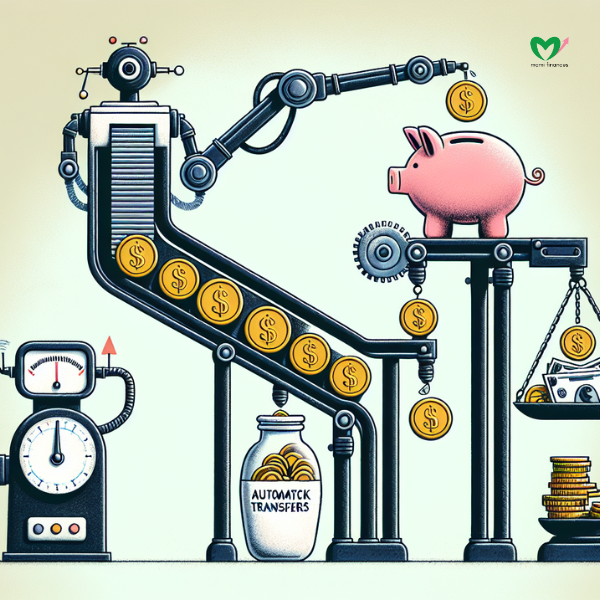The Best 6 Month Money Challenge
Welcome to the journey towards financial freedom! In this 6-month money savings challenge, you will embark on a path that will transform your financial life. Financial freedom is about having control over your money and being able to live life on your terms. Participating in a money savings challenge can provide you with the tools and motivation to achieve your financial goals.
Whether you are a beginner or an experienced saver, this challenge is designed to help you save more money and make the process enjoyable. Let's dive into the strategies and steps that will lead you to a brighter financial future.
Explaining the importance of financial freedom
Financial freedom is the ability to live life on your own terms without being limited by financial constraints. It provides a sense of security, peace of mind, and the freedom to pursue your dreams and goals. Achieving financial freedom allows you to have control over your money rather than being controlled by it.
It gives you the power to make decisions that align with your values and priorities, whether it's traveling the world, starting a business, or enjoying a comfortable retirement. Financial freedom also eliminates stress and anxiety that may arise from living paycheck to paycheck.
By participating in a money savings challenge, you are taking the first step towards achieving financial freedom and creating a better future for yourself.

Benefits of participating in a money savings challenge
Participating in a money savings challenge offers several benefits. Firstly, it provides a clear and structured framework for saving money, making it easier to stay motivated and track your progress. Secondly, it helps develop good financial habits by encouraging mindful spending and prioritizing savings.
Also, a money savings challenge can help you identify unnecessary expenses and find creative ways to cut costs. It also serves as a great opportunity to explore additional sources of income and increase your savings potential. By participating in this challenge, you can achieve your financial goals faster and gain a sense of accomplishment and empowerment.
Setting Your Savings Goals
Setting clear and specific savings goals is crucial for a successful money savings challenge. Start by determining your financial aspirations and what you want to achieve in the next six months. It could be building an emergency fund, saving for a down payment, paying off debt, or planning a dream vacation.
Once you have identified your goals, break them down into smaller milestones for each month. This will make it easier to track your progress and stay motivated. Remember to be realistic with your goals and set achievable targets that align with your income and expenses.
Determining your financial goals and aspirations
When starting the 6-month money savings challenge, it's important to have clear financial goals and aspirations in mind. Take some time to reflect on what you want to achieve in the next six months. Do you want to build an emergency fund, save for a down payment, pay off debt, or plan a dream vacation?
Whatever your goals may be, write them down and keep them in mind throughout the challenge. Having a clear vision of what you want to achieve will help you stay motivated and focused on your savings journey. Remember, everyone's financial goals are unique, so make sure your goals align with your personal aspirations and financial situation.
Creating a realistic budget
Creating a realistic budget is a crucial step in achieving your financial goals during the 6-month money savings challenge. Start by evaluating your income and expenses to determine how much you can realistically save each month. Identify areas where you can cut back on expenses, such as dining out or entertainment, and allocate that money towards savings.
Prioritize your spending based on your goals and eliminate unnecessary or impulsive purchases. Consider using budgeting apps or spreadsheets to track your expenses and stay accountable. Remember, a realistic budget takes into account your income, expenses, and financial goals, allowing you to save and achieve financial freedom.
Month 1: Cutting Expenses
In Month 1 of the 6-Month Money Savings Challenge, the focus is on identifying and cutting unnecessary expenses. This is a key step towards achieving financial freedom. Begin by evaluating your spending habits and pinpointing areas where you can make reductions.
Consider cutting back on non-essential items such as dining out, entertainment, or subscriptions. Implement cost-saving strategies like meal planning, shopping with a list, and comparing prices before making purchases.
Use budgeting tools or apps to track your expenses and set a spending limit for each category. You will start building the foundation for a successful savings journey by cutting expenses and prioritizing your spending.
Identifying unnecessary expenditures
One of the key steps in the 6-Month Money Savings Challenge is to identify and cut unnecessary expenditures. This involves evaluating your spending habits and pinpointing areas where you can make reductions. Take a closer look at your monthly expenses and determine which ones are non-essential or can be minimized.
This may include dining out, entertainment, or subscriptions that you can temporarily pause or eliminate altogether. By identifying and cutting these unnecessary expenditures, you can free up more money to put towards your savings goals. Remember, every dollar saved is a step closer to achieving financial freedom.
Implementing cost-saving strategies
In the second month of the 6-Month Money Savings Challenge, it's time to focus on implementing cost-saving strategies. This involves finding ways to reduce expenses and make smart choices with your money. Here are a few strategies to consider:
- Create a meal plan and cook at home: Eating out can quickly drain your savings. Planning your meals and cooking at home can save money on dining expenses.
- Use coupons and take advantage of sales: Look for coupons and discounts when shopping for groceries, clothing, or household items. Take advantage of sales and promotions to maximize your savings.
- Cancel unnecessary subscriptions: Review your monthly subscriptions and cancel any that you don't use or need. This can free up extra money to put towards your savings goal.
- Use energy-saving measures: Implement energy-saving measures in your home, such as using LED light bulbs, adjusting the thermostat, and unplugging electronics when not in use. These small changes can add up to significant savings on your utility bills.
- Shop around for better deals: Before making a purchase, compare prices from different stores or online retailers. Look for discounts or better deals to ensure you're getting the best value for your money.
Remember, every penny saved adds up over time. By implementing cost-saving strategies, you can make significant progress towards your savings goals during the 6-Month Money Savings Challenge.

Month 2: Increasing Income
The focus shifts to increasing income in the second month of the 6-Month Money Savings Challenge. This involves exploring additional sources of income and finding ways to maximize earnings. Consider taking on a part-time job, freelancing, or starting a side business to generate extra income. Utilize your skills and passions to identify opportunities that align with your interests.
Also, take advantage of online platforms and marketplaces that allow you to monetize your talents or sell products. Remember, every dollar earned can contribute towards your savings goals. Stay motivated and proactive in seeking out income-boosting opportunities throughout the month.
Exploring additional sources of income
In the second month of the 6-Month Money Savings Challenge, individuals are encouraged to explore additional sources of income. This can be done by taking on a part-time job, freelancing, or starting a side business. Utilizing one's skills and passions is important to identify opportunities that align with their interests. Online platforms and marketplaces are a great way to monetize talents or sell products.
By seeking out income-boosting opportunities, individuals can increase their earnings and contribute more towards their savings goals. Remember, every dollar earned counts towards achieving financial freedom. Stay motivated and proactive in finding ways to maximize your income.
Tips for maximizing earnings
- Look for opportunities to monetize your skills or talents. Whether it's freelancing, taking on a part-time job, or starting a side business, finding ways to earn extra income can significantly boost your earnings.
- Utilize online platforms and marketplaces to sell products or offer services. These platforms provide a wide customer base and easy access to potential buyers.
- Consider investing in yourself by acquiring new skills or certifications that can increase your value in the job market.
- Stay updated on industry trends and developments to identify new income-generating opportunities.
- Network with professionals in your field to explore collaborative projects or partnership opportunities.
- Be proactive and persistent in seeking out additional sources of income. Don't be afraid to try different approaches and pivot when necessary.
- Track your earnings and expenses to evaluate the effectiveness of your income-maximizing strategies and make adjustments as needed.
Remember, every dollar earned brings you one step closer to financial freedom. Stay motivated and dedicated to finding ways to maximize your earnings and achieve your savings goals.
Month 3: Building an Emergency Fund
Now that you have started to cut expenses and increase your income, it's time to focus on building your emergency fund in Month 3 of the money savings challenge.
Having an emergency fund is crucial for financial security and peace of mind. It acts as a safety net to cover unexpected expenses like medical bills or car repairs, without relying on credit cards or going into debt.
To build your emergency fund, prioritize saving a certain amount from your income every month. Consider automating your savings by setting up automatic transfers from your checking account to a separate savings account designated for emergencies. This way, you won't be tempted to spend the money and it will continue to grow over time.
Remember, the goal is to save enough to cover 3-6 months' worth of expenses. If you encounter any unexpected expenses during this month, try to rely on your emergency fund instead of turning to credit cards or loans. Stick to your budget and continue to evaluate your expenses to ensure you are on track to reach your goals.
Understanding the importance of an emergency fund
An emergency fund serves as a financial safety net, providing a sense of security and peace of mind. It is designed to cover unexpected expenses such as medical bills, car repairs, or job loss without relying on credit cards or going into debt.
Having an emergency fund allows individuals to handle unforeseen circumstances without disrupting their long-term financial goals. It acts as a buffer, preventing the need to dip into savings earmarked for other purposes. By prioritizing the building of an emergency fund, individuals can protect themselves from financial stress and maintain stability in their lives.
Strategies for saving and growing your emergency fund
One of the strategies for saving and growing your emergency fund is to automate your savings. Set up automatic transfers from your paycheck to a separate savings account dedicated to your emergency fund. This will ensure that a portion of your income is consistently being saved without any effort on your part.
Also, consider cutting back on discretionary spending and redirecting those funds toward your emergency fund. Look for areas where you can trim expenses, such as eating out less frequently or reducing entertainment expenses.
Lastly, consider exploring investment options that offer higher returns for your emergency fund, such as high-yield savings accounts or low-risk investment vehicles. By implementing these strategies, you can steadily increase your emergency fund.
Month 4-6: Developing Long-term Saving Habits
During the final months of the money savings challenge, it's essential to focus on developing long-term saving habits. This means finding best saving methods for you and incorporating them into your daily life. Consider setting up automatic transfers to a savings account so a portion of your income is consistently saved.
You can also explore different saving strategies, such as the 50/30/20 rule (allocating 50% to needs, 30% to wants, and 20% to savings) or the envelope system (using cash envelopes for different budget categories).
Stay motivated and consistent by regularly tracking your progress and celebrating milestones along the way. Maintaining these habits beyond the six-month challenge is crucial to continue building your savings and achieve long-term financial freedom.
Exploring different saving methods
When it comes to saving money, there are various methods you can explore. One popular strategy is setting up automatic transfers to a savings account. This allows a portion of your income to be consistently saved without even thinking about it. Another approach is the 50/30/20 rule, where you allocate 50% of your income to needs, 30% to wants, and 20% to savings.
The envelope system is another effective method, where you use cash envelopes for different budget categories to ensure you stay within your spending limits. Ultimately, finding the saving method that works best for you is key to developing long-term saving habits and achieving financial freedom.
Tips for staying motivated and consistent
Staying motivated and consistent throughout the 6-month money savings challenge is crucial for achieving your financial goals. Here are some tips to help you stay on track:
- Set small milestones: Break down your savings goals into smaller, achievable milestones. Celebrate each milestone to stay motivated.
- Visualize your goals: Create a vision board or keep a picture of your financial aspirations handy to remind yourself of what you're working towards.
- Stay accountable: Share your progress with a friend or join an online community of like-minded savers. Being accountable to others can provide the extra motivation you need.
- Reward yourself: Set up small rewards for reaching certain milestones or sticking to your savings targets. It could be treating yourself to a small indulgence or taking time for self-care.
- Track your progress: Regularly monitor your savings progress to see how far you've come, which can give you a sense of satisfaction and motivation.
Remember, saving money is a journey, and staying motivated and consistent will help you stay on track toward financial freedom.

Conclusion
In conclusion, the 6-Month Money Savings Challenge is a powerful tool to kickstart your journey towards financial freedom. By setting realistic goals, creating a budget, cutting expenses, and increasing your income, you can start building your savings and working towards a more secure financial future.
Building an emergency fund and developing long-term saving habits are essential steps in achieving your financial goals. Staying motivated and consistent throughout the challenge is key, and by celebrating milestones and tracking your progress, you can stay on track and achieve success.
Remember, financial freedom is within reach, and the 6-Month Money Savings Challenge can help you get there.
Summary of the Money Savings Challenge Journey
The 6-Month Money Savings Challenge is a transformative journey toward financial freedom. Participants learn to prioritize their financial aspirations by setting realistic savings goals and creating a budget. In the first month, they identify and cut unnecessary expenses; in the second month, they explore ways to increase their income.
Month three focuses on building an emergency fund, understanding its importance, and strategies for saving and growing it. Finally, months four to six are dedicated to developing long-term saving habits and staying motivated. By consistently following the challenge, participants can achieve their financial goals and lay the foundation for a secure future.
Importance of sticking to your financial goals
Sticking to your financial goals is crucial for achieving long-term financial freedom. You build the foundation for a stable and secure future by staying disciplined and committed to your goals. It allows you to make conscious decisions about spending, saving, and investing your money.
By maintaining focus and resisting the temptation to deviate from your financial plan, you can avoid unnecessary debt, save more effectively, and reach your goals faster. Sticking to your financial goals also helps you develop good financial habits that can benefit you throughout your life. Remember, consistency is key to financial success.






